|
|
This page is for people who are creating their own CCG. Be they making a plugin for Lackey or not, I think all CCG designers will get something out of this page. If you have any additional tips, comments, or questions, please send them to trevor@lackeyccg.com so that I may add them to this site. If you are looking for a tutorial on how to make a plugin for LackeyCCG, go here.
Over the course of this page, I will reference where existing CCGs did something good, and where they kinda goofed.
 |
| You will never play a card called "Fold the Laundry". |
A CCG with the best gameplay mechanics will fall flat if no one cares about playing it.
Creating a CCG is a balance between making it comprehensible and making it fun. It needs to be easy enough to pick up, yet have enough strategy and novel gameplay for it to be fun. Whether your game has a fantasy theme, a sci-fi theme, a political theme, or something completely different, it is essential to a player's enjoyment that he feels he is a part of something fantastic and interesting. When a Magic player casts Lightning Bolt on his opponent's creature, he is not merely thinking of it as an efficient means to negate a reusable threat (a creature). He is thinking "I am summoning forth a bad-ass LIGHTNING BOLT and zapping the bejeezus out of that critter that is pissing me off." You may not be so dorky as to really "get into" playing Magic like this, but this imagination is the underlying driving force of what makes a CCG fun to play.
You will never play a card called "Fold the Laundry".
You need to establish a creative atmosphere, one players will care about and have fun in.
One easy way to have a fun atmosphere for your CCG is simply to adopt an existing franchise and create a CCG out of it. For example, you could make up a card game version of Star Wars, Lord of the Rings, Warcraft, Pokémon, Battlestar Galactica, or anything else. (Each of those examples already happen to have 1 or more CCGs based on them.) Really, any very popular movie, tv, comic, video game or book series can be used. If you go this route, you will have an easy time finding a fan base, a very easy way to get art for card images, and the CCG design might naturally flow from the subject matter. The down side to this alternative business method is that you will need to license the franchise you choose, or scale your CCG down to the scope of just a fan-fic item.
 |
| J. R. R. Tolkien, the inventor of modern fantasy. |
The other route to getting a theme for your CCG is to make one up from scratch or otherwise. The most popular and first CCG did just this. Magic: the Gathering writes original stories and artistic elements for their products. But Magic itself is based on the fantasy genre, so it didn't exactly reinvent the wheel. Magic was created as a game for people to play when they were not playing Dungeons & Dragons. Hence, the fantasy elements of Magic drew greatly upon a previous work. Dungeons & Dragons itself was derived largely from the stories of J.R.R. Tolkien, so they didn't start from scratch either. So if you want to go this route, you don't need to start from scratch either. For example, you can make a CCG about spies and draw heavily from elements present in movies like the James Bond series.
Other material you can draw upon is historical events. You can make a CCG based on one or more real present or historic cultures. You could make a series about vikings, egyptions, romans, feudal japan, or any other rich culture. Remember that players enjoy fantastic elements, so for example if you make a viking-based game, you should consider adding norse gods, magical elements, and other larger-than-life characters, events, and abilities.
Any way you go, just make sure you clearly define your thematic universe, and make sure people want to invest their time becoming immersed in it. It is possibly the most important thing a CCG designer does.
A very important part about making the game interesting is the artwork.
Try to make the picture on the card as large as possible. And try to make the card template design as cool as possible (without getting in the way). A picture is worth a thousand words. More than anything, a player enters your fictional world via the pictures on the cards. Personally, I will not even attempt playing a CCG if its card art is lame or its card template is clunky. The appearence of a card is the first impression people get of your CCG. If it doesn't appeal to them, it will also be their last impression.
Card art is iconic. After a player sees a card a few times, he can just look at the picture at a glance and know what the card does.
To get pictures for your cards, you can draw them yourself, look on the internet for copyright-free images, or you can even use photographs (and perhaps stylize them in photoshop). You can also ask an artist if you can use a few examples of his or her work.
| A quick sidenote on using the term CCG or TCG... |
People sometimes refer to CCGs or TCGs.
TCG stands for "Trading Card Games".
CCG stands for "Collectible Card Games" or "Customizable Card Games".
I think TCG is a bad term because people don't necessarily trade their cards much or at all. Also, it confuses it with "Trading Cards" such as those as collectors' items about movies, or sports, or other things that aren't used to play as a game.
"Collectible Card Games" is better than "Trading Card Games" because in order to make a deck, you must collect the cards to do so. And while you don't necessarily trade, you are necessarily collecting cards as you create a deck. However, this terminology has the same pitfall as "Trading Card Games" in that the focus is on collecting the cards, and it implies they are merely a collector's item.
"Customizable Card Games" is the best term because the essence of what makes a CCG fun is the ability to customize your deck to your tastes, strategy, and skill. Unlike a game of chess, a deck builder uses artifice to craft a deck before the game even starts. This allows him to try different parts to ultimately make the best possible deck. I think a good CCG is designed such that there is no "perfect deck" and that decks can always be improved.
So, in conclusion, I think Customizable Card Game is the most appropriate term, and if you prefer Collectibale Card Game, you are still using the same abbreviation. So I encourage you to refer to them as CCGs and not as TCGs. |
A game should be fun whether you win or lose.
Make sure your CCG never gives a player a foregone conclusion in their victory or especially their defeat, unless the game will end very shortly thereafter. In Decipher's Lord of the Rings CCG, each player competes in a race to get to the final site on the site path. If one player gets a decent lead, it is almost impossible for his opponent to catch up, but the game must still be completed. This can be very unfun for the losing player. A game should be able to build up and have constant struggle, but also there should be cards that will greatly swing the game. But cards that greatly swing the game can also give players a feeling that the game is too random, so they must be designed carefully.
Avoid mechanics that encourage tedious busywork or memorization.
Decipher's Star Wars game, and later Decipher's Wars game, make use of a clumsy resource mechanic where you move cards from one pile to another, and then to another pile, and then to the bottom of another pile. Some players will remember which cards were in these piles and the order in which they were stacked. Unless you are Rain Man, you will likely not want to memorize cards. Don't encourage players to do things that aren't fun in order to gain a tactical advantage.
Don't be different for the sake of being different.
If one mechanic is much better than another, even though it has been used before, use the superior mechanic. If the mechanics are comparable, it is a viable option to use one that may be slightly worse if the originality it provides is novel enough. CCGs have been around for a while now and there have been lots of inventions in mechanics that make games work better. Use these tools to make your CCG work. Don't feel like you need to reinvent the wheel. It can only help your design to study other CCGs and find out what their strengths and weaknesses are. After a CCG is created, because of a lack of initial foresight in design, some problems get entrenched in the CCG. Consider how Magic decks can get "mana screw". (In case you aren't familiar with Magic: the Gathering, "mana screw" is where you draw either too few resource cards and hence cannot play anything, or where you draw only resource cards and have nothing to play.) World of Warcraft CCG, no doubt aware of mana screw, designed their game to avoid "mana screw".
Use the lowest common demonator
Some card games take game stats and arbitrarily multiply them by 10, 100, or even 1000. YuGiOh is an example of this. A card may have an attack value of 500, yet no card in the game uses a value of less than 100. So they all might as well be divided by 100 and simplify things. This is just bad CCG design, pandering to children who associate big numbers with power. Wizard's Star Wars game also does this for the Speed stat. For some reason, they multiply the speed stat by 10 on every card.
| Card restrictions create variety |
It is very important that your CCG incorporate a mechanism to restrict which cards can be played with other cards. If you could freely play with all cards, people would only choose the best cards and use only them. If, on the other hand, you had to choose to play card A OR card B, or you had to work hard to get to play them together, deck creators have a lot more choices. And choices are what make deck construction interesting. Different existing CCGs have found many ways to incorporate this concept into their design.
Limit by Resources: Magic: the Gathering chose to separate cards into different colors, each with strengths and weaknesses. To play a card of a particular color, you need a resource corresponding to that color. So multiple color decks are possible, but with each added color, it becomes more and more difficult to get the appropriate resource to play any specific color.
Limit by Deck Construction: WoW uses Class to restrict the types of cards you can use. Before you make a deck, you choose a class, and then you can only put cards in your deck if they are neutral or of your class. WoW also uses Faction to restrict the types of cards you can have in your deck. Before you build your deck, you choose Horde or Alliance, and you can only include neutral cards, or cards from your faction in your deck. So with this double restriction, you can have a Horde Druid deck, a Alliance Druid deck, an Alliance Rogue deck, and many other combinations, and each will have a different set of possible cards that can and cannot be included in it.
Limit by Efficacy: Decipher's Lord of the Rings CCG allows you to include cards of any type in your deck, but cards of a particular faction tend to work a lot better if they are grouped with other cards from the same faction. There are many cards that say "To play this, spot a hobbit you control" or "Target elf gets +2 strength" or "This card costs 1 less for each dwarf you control." So you could put all of those cards in one deck, but the deck would be so unfocused that it wouldn't be very effective.
Limit by Penalty: This is similar to the previous kind of restriction, except there is a specific penalty. Warlords CCG allows you to play with cards from any faction other than your chosen faction, but each card played of a different faction essentially costs 1 more in is cost system.
Implicit in this concept of different groups of cards you can play is that each different group should feel different from the others. Otherwise, the groupings would feel arbitrary. Consider a game where each card was assigned a letter A, B, C, or D, and that you could only put cards with the same letter in your deck. If these letter assignments were random, it woudln't make much sense to a player why they shouldn't be able to include the other cards. On the other hand, if all cards in the A group were "Good", and all cards in the "B" group were "Evil" then it would start to make a lot more sense as to why they aren't allowed to be put in the same deck. If cards in the C group were great at utility things (like drawing extra cards) and cards from the D group had powerful characters, players would feel like choosing a group over another group was a meaningful choice.
In order to make a choice meaningful, you need to gain something and lose something. Whenever a player chooses one card, he is effectively not choosing every other card that could fill that card's slot in his deck. The same goes for choosing a "faction" that is constrained by the limiting factors defined above. It is these choices that make the final deck you make feel like your own personal creation. And that ultimately makes playing a more immersive experience as you see how your choices affect the game. |
Correlation of Mechanics to Flavor
When you add a counter to a card, or draw a card, or turn a card, or use any mechanic in your game, it should be apparent to all players what this represents flavor-wise in your CCG's world. Drawing a card may represent doing research or gathering resources. Adding a counter to a card may represent that card sustaining damage, or building up a cache of supplies. If players are to be immersed in your game, they should be able to infer what is going on when a mechanic happens. That being said, you don't need to state the obvious. Consider these 3 approaches to the same card.
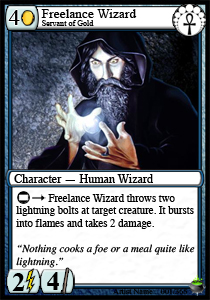 |
 |
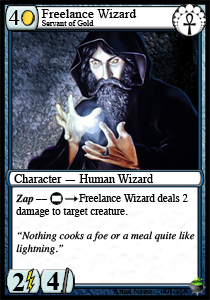 |
| Too much flavor muddles important game text. |
With clear game text, the flavor is clear from both the art and flavor text. |
Adding a flavorful label gives players a shortcut, but doesn't really get in the way. |
The example on the left tries to mix flavor text with important game text. This can make the actual important game text a lot more confusing to understand, and on more complicated cards, you will either have to spend more space making it as flavorful as other cards or make it without flavor, thus introducing inconsistency with the way cards are worded. Compare it to the middle card which doesn't put any flavor text in the actual game text of the card. You really aren't losing any flavor because it is evident by the art and flavor text (and the imagination of the players) how the mechanic correlates to the flavor. The card on the right adds one extra superfluous flavor element: a flavorful label for this ability. Adding a label complicates things a bit, but it also provides players a quick way to communicate which ability you are using. There are good reasons for using the methods of the middle and right cards, but I strongly suggest you avoid doing things the way the left card does.
| Representing "Damage" |
Most CCGs have character (or creature or unit) cards, representing people, monsters, armies, vehicles, or even buildings. When these characters get damaged, there are 3 common mechanics different CCGs use to represent this.
Counters: The most straight forward method is using damage counters and placing them on the damaged card. This is good in that it is a quickly visually assessed stat which can persist from turn to turn. Also, you can incorporate mechanics to remove these counters, which very easily correlates the mechanic with the flavor of what these damage counters represent. This can quickly become a clumsy mechanic because with lots of counters on the table, it becomes difficult to move cards around. Also, wrangling counters can get in the way of playing, especially when you start to run out of counters and need to switch to using dice. Also, some card mechanics (like a card building up storage counters) can only be done with counters, and having damage counters and other kinds of counters can get really confusing. Try to be clever and design your game such that you don't need to use damage counters.
Damage goes away at the end of turn: The first CCG, Magic: the Gathering, doesn't need to use damage counters. If a character receives a certain amount of damage in one turn, it dies. If not, it remains. From a flavor standpoint, this represents survivors of a battle healing after the battle takes place. From a mechanics standpoint, people can easily remember how much damage is done to a character in one turn without resorting to counters. Counters are needed when it becomes tricky to remember things as time goes by. Try to design a system where you don't need to remember things for that long. Playing should be fun – not a chore of memorization.
Turning cards: One way to represent damage done to a card is to turn it, either 90, 180, or 360 degrees. Perhaps a card cannot be used if it is turned, and each turn it rotates back a step. There are many ways to do this, and it is a mechanic you should consider.
Sending cards to your hand or to a damage area of the table: This is another way that games like Pokémon use.
A final note on representing damage is that you should be careful how you choose your game terms. If your game only has characters and monsters, you may want to use the term "wound". If you have buildings and vehicles, the term "wound" seems inappropriate. Similarly, when a unit "dies", this is appropriate for a living unit, but for a building or zombie, it starts to lose meaning. In that case, the more general term of "destroy" seems better than "die". If your game only has one type of unit, you can be more specific, but if it doesn't you will want to use more generic terms. |
Randomness
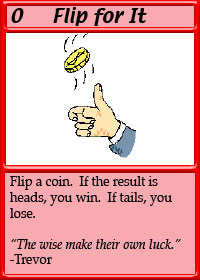 |
| Too much randomness is not fun for either player. |
Randomness is an important part of a CCG. It keeps games fresh and exciting. Even when it seems like you are going to lose a game, there is always that chance that you will draw the one card that will save you and win you the game. Unless you built a good deck, it probably won't happen, but the chance that it could keeps the game interesting. And even for the player in the lead, the chance they he might lose out of the blue also makes the game more interesting.
Randomness gives less adept players a chance to win. Even the best player playing the best deck can lose to a mediocre player with a mediocre deck. It is not likely, but it's possible. If a novice player knows he has no chance of winning against a stronger opponent, he probably won't want to play very much. So randomness encourages people of all skill levels to play.
There is such a thing as too much randomness though. When games become too random, players might as well flip a coin to decide who wins instead of playing. There is a CCG called Warlords which requires players to roll a 20-sided die for every character that attacks. I have always felt that this caused Warlords games to be too random. As a novice with a preconstructed deck, I managed to beat an experienced player about 50% of the time. When I did manage to win, the victories seemed shallow.
When designing your CCG, make sure you make it random enough to be interesting and fresh, but not so random that chance is a significant factor in who wins. You also should define a minimum size for a deck so that there is enough randomness in what cards you draw.
Methods of winning and losing |
There are several methods for winning (or losing) a game used by many CCGs. I suggest you use a primary victory condition and incorporate one or more secondary victory conditions in case the primary victory condition becomes deadlocked. Also, multiple ways of winning encourage different deck designs, which can make playing more interesting. Here is a partial list of different victory conditions.
Gaining or reducing some stat: This is what magic does with its 20 Life points that you must reduce to 0 to win. Wow CCG does the same thing in reverse where you start off with 0 damage and if you reach a certain amount, you lose. Be careful you use a stat that is not unweildy as this stat will directly affect the speed of a game. I would suggest between 10 and 30. Each increment should be meaningful, but the game shouldn't go on too long either. Pokémon also does this with its Prizes. A twist to this is using multiple stats. For example, a winner must get 10 Power AND 10 Influence points to win. Alternatively, your game may let you win by getting 10 Power OR 10 Influence points.
Assassination: This is where the objective is to kill one specific unit, often representing the player. Warlords CCG does this and so does Decipher's Lord of the Rings. It is an interesting mechanic where you have to be both defending yourself, while at the same time you are trying to kill one specific target of your opponent. An assassination mechanic can be very immersive. The difference between an assassination objective and the aforementioned stat-reducing objective is that the assassination target is clear and on the table and each player has a clear goal as far as which unit they want to kill above all else. In Wow TCG, strictly speaking, the objective is to kill a single target: their hero. But their hero's life points are around 28, so in practice, it is more like Magic's 20 life total. Warlords and Ring-bearers (in Warlords TCG and Lord of the Rings, respectively) have about 3 or 4 life points, so a player must always try to protect their fragile avatars.
Domination of game state: Wizard's Star Wars has 3 arenas. At the end of each turn, if you control 2 out of 3, you win the game. This is a nice balanced victory condition. It is also a nice change of pace from what most CCGs do.
Last Man Standing: when you kill all of your opponent's units. This is kind of a combination of Assassination and Domination of Game State, and could technically be considered as either. The difference with Assassination is that no single unit is all important. And Domination of game state victories are usually about getting a specific board position. Last Man Standing doesn't need any complex game state elements such as different arenas. Usually, a last man standing game will start out with each side getting a small force, and during the game bolster it while weakening their opponent's force.
Decking: When you reduce the number of cards in your opponent's deck to 0. This is a good secondary win condition, as it allows for a clear victor if for some reason players get in a deadlock. It isn't a good primary win condition for 2 reasons. First, it can take a long time to deplete a deck which is large enough to allow for a healthy amount of randomness. Second, it isn't fun to see the cool parts of your deck be ripped away from the game. It is a lot more exciting when you draw a card if it might be the cool one you are hoping for. Losing the chance to play your cool cards is demoralizing.
You Win: These are cards that say "You win if..." and then they have conditional requirements. These cards are interesting, but they should be used very rarely. Since winning is the ultimate goal of the game, making a fair "you win" card will require objectives that are very difficult to achieve, because it essentially circumvents playing the game otherwise. You Win cards shouldn't be the main objective to winning your CCG. They shouldn't even be a secondary win condition. They should be rare exceptions to the rules of your game that are warranted on a case by case basis. |
| Resources, governing the power level of cards |
During the course of the game, it is more dramatic if powerful cards get played. But if you can play some powerful cards, why not have every card in your deck be as powerful? In order to provide exciting gameplay, your CCG must use resource management as part of its mechanics. The most straight forward way to do this is with different costs of cards. Powerful spells should cost more than weak spells. How this is achieved is with resources.
Magic: the Gathering uses lands as a resource. A certain percentage of your deck in Magic, usually about 40% of it, is solely there to allow you to play the other 60% of it. Each of your turns you get to play one land from your hand, if you have one to play, and as turns go on, you can play more powerful cards. One problem with this method is that due to the randomness of your deck, occassionally you will not draw the right kind of card (land in this case) in order to play the cards you do have. In Magic, this is refered to as "mana screw" or "land screw".
A relatively newer CCG, World of Warcraft TCG, does something similar. WoW allows you to play any card in your hand face down as a resource. Some cards, "quests", when played as resources, will give you an extra effect. This eliminates the mana screw that will occassionally frustrate a magic player. However, some people think that the Magic way encourages careful deck construction as a means of avoiding mana screw.
Another resource strategy is having stronger cards enter play in a crippled state. Warlords, for example, has very strong units come into play in the back row, and they need to gradually be moved up to the front lines to be effective.
Another resource strategy is having the more powerful cards require certain game states in order to enter play. For example, you need to have a certain life total, number of other units, or some other game element that is hard to obtain.
Alternatively, you could employ a simpler one-at-a-time strategy where you can play any card, but only one card each turn. This approach doesn't really mitigate the power level gap between cards, so it will greatly restrict what you can do while still keeping the game balanced.
Capturing resources is another strategy. Suppose that you gain a certain amount of resource points from each location card in play that you captured. As the game goes on, and you steal more locations away from your opponent, you will have a great lead over them. This is a bad approach because the winner gets an unfair advantage as the game progresses, and the conclusion of the game is inevitable. A fun game is where each player has a chance to win at all times and if you undermine the underdog, the game is less exciting for both players. This same principle is why in many racing games, the people who aren't in first place actually get (often hidden) speed buffs in order to give them a fighting chance. |
Power creep, the death of your CCG
A long running card game will die quickly from power creep. Power creep is where the cards in a new set largely make obsolete the cards in a previous set. As sets go on, the effect gets worse and worse. Greedy and shortsighted CCG designers may want to make a new set interesting to new players by attempting to up the power level, but this is perhaps the worst thing you can do to your CCG's longevity as a whole. Its bad for a number of reasons. For long time players of the game who have amassed a large collection, its a big "screw you, your hard-earned collection is worthless". It can greatly affect the speed of a game. It can make different deck archetypes obsolete. It can undermine the basic workings of your CCG. It's an awful idea. Stagnation is bad for a CCG, but increasing power level is not the solution. New design space needs to be invented which is of a similar power level as previous cards. And if you ever release an overpowered set, you need to do damage control ASAP to avoid power creep. This damage control could be in the form of banning certain cards, restricting certain cards, making errata, or making new cards to hose problem cards.
It's better to have an under-powered set than an over-powered one. An under-powered set will merely be a dud. An over-powered set will kill your CCG.
Complexity: K.I.S.S. (Keep it simple, stupid!)
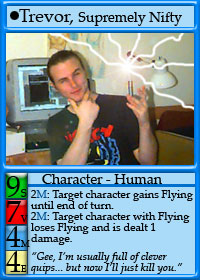 |
| Don't complicate things more than this. |
 |
| Less is more. |
Be careful not to try to do too much in your card game. Decipher's Star Wars is a card game which allows you to have space battles, land battles, site controlling, transportation between sites, light-saber battles and a number of other complicated things. On the positive side, once you know how to do everything, you really can feel like you are in the Star Wars universe. On the negative side, the game is so complicated it is very hard to get into. Don't try to have your game do too much, or else people will be overwhelmed, especially new players. And remember that everyone is a new player at some point.
As the designer of a CCG, what ever you come up with will seem obvious to you. When you design a CCG, remember that you are creating it for other people and not for you. Make it easy to learn and challenging to master.
Try to keep the complexity on cards themselves down too. Consider the example to the left. That is a lot to read, a lot to forget, and a lot to keep track of. And you have to squint to read it.
Really try to make a card's text as succint as possible and don't try to do too much in one card. The card on the right is flavorful, but not too cluttered. It even has enough room for flavor text. There is no harm in having a card with no rules text. A simple unit card, which just has the essential stats inherent in the card's type, is perfectly fine. A card with no special rules text is often called a "vanilla" card. Just because a card doesn't do something fancy doesn't mean that it isn't an important part of the game. New CCG designers often overlook this. Many CCG designers make their CCG too complicated. You can get a lot of complex strategy from simple parts. Consider the volumes of chess strategy books while the complete rules of chess can be summed up in a paragraph.
The card on the right makes use of several tools to make gameplay easier.
The dot to the left of the card title means you can only have one in play at a time. You can use a different symbol, or a symbol to indicate that you can only have one in your entire deck. Just be consistent. The stats on the card are color coded, standing for Strength, Vitality, Mind, and Energy. Note that there is a little letter to help players (especially new players) remember what each stands for. You can also use a symbol, or have a big symbol and put the number over the symbol.
You might also want a symbol to designate which expansion it comes from, or its rarity. You may also want to print the card's collector number.
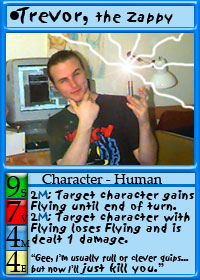 |
| Don't be tempted to use funky fonts. |
Fonts
Resist the urge to use funky and cool fonts. They may look cool, but in the long run they are just not worth it. If you ever need to use a lot of text and decrease the font size, weird fonts can be very hard to read. And you don't want to be using one font on one card and another font on a different card. Things would quickly start looking mismatched. Look at the card to the right: Trevor, the Zappy. That is a cool font, but altogether a bad choice for a CCG card.
Magic: The Gathering has been around for over 10 years now. It was the first CCG, and they got a lot right, but they also made a few misteps. Eigth edition and the new card design of magic cards since eigth edition try to correct some of these problems. The new cards have a larger picture and a less funky font. But some things were just too late to do anything about. For example, what the heck is "the gathering" anyway? When you design a card back, make sure you are really happy with it, because there is no going back. With LackeyCCG, it doesn't so much matter because you can easily update the card back image, but if you are going to print your cards, you want your new card backs to match the initial one so the cards can be mixed and modular.
When CCG designers make cards, they often design them as large versions. This tends to make designers make the fonts the wrong size relative to a printed card. I suggest you design a template, and then temporarily shrink it down to a width of 200 pixels. If the font is too small to read at that size, you should rethink your font size.
Different Card Designs for different types of cards.
 |
| Different card template designs are nice visual cues that make learning and playing a game easier. |
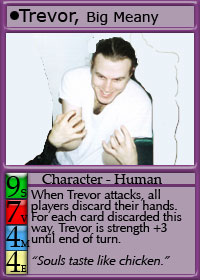 |
| This card design has some things in common with the Axe, but it is different in other ways. |
It is very handy to have different types of cards look different, but standardized in a way too. You can have a different template theme for each color, or affiliation, or culture, or race, or however your card game is divided. Each of those groups will probably have the same card types, like event, action, item, enchantment, or some other card type within a faction.
The cards to the left and right are clearly from the same faction (in this case purple). And clearly one is a character, like the blue character cards above. The one to the left is clearly not a character.
Uniformity of design allows people to clearly see what is and is not the same on cards.
Keywords
A keyword is a word or short phrase that acts as a short cut for a lot of rules. In Magic: the Gathering, for example, Flying and First Strike are keywords. There are active and passive keywords. Active keywords have an immediate effect on the game, like the ones I just mentioned. A passive keyword has no direct effect on the game, but other cards reference them. In magic, creature types are passive keywords. Card types are implicit keywords because they are there anyway and can always be referenced. Your game might have a passive keyword "Heroic", or "Marksman", or "Hacker" or what ever. Another card may reference a passive keyword like "This card does X damage where X is the number of Hacker's you control." So they stand out, I suggest you make the keywords in your card text bold. And whenever possible, try to include reminder text to explain active keywords. Reminder text is explanation text as to what active keywords mean, often in parentheses and in italics. Reminder text is a great way to teach new rules and abilities to new players or to refresh the memory of old players.
You may wonder "What's the purpose of making an active keyword if I use reminder text anyway?" There are a few reasons. First, sometimes there just isn't room to write down all the reminder text on the card. Also, by giving an ability a uniform name, gameplay is easier. For example, with Magic, rather than say "My creature can deals damage during the first strike damage step" you can say "my creature has first strike". Try to make gameplay as smooth as possible. Gameplay mechanics should allow cool things to happen, not get in the way of it.
Try to minimize the number of keywords in your CCG, or at least active keywords. Warlords has so many keywords that it is difficult to remember them all, especially for new players. Put reminder text as often as you can to help new players.
Flavor Text
Flavor text is words or phrases on cards to help convey the story of the card. Flavor text makes players more immersed in the game by making the fanatasy world more rich. It can also help convery how the mechanics of a card correlate to the flavor of what the card "does" in the fantasy world. Cards with a lot of rules text don't always have room for flavor text, but most cards will if your card design is good. One very important thing about flavor text is it should have NO affect on the actual game. Otherwise, it would be one more thing people would have to remember. What would otherwise be a fun thing to read while you are waiting for your opponent to think becomes a chore to study. Decipher's Star Wars game would often insert passive keywords into flavor text. You shouldn't mix gameplay text and flavor text.
A sample card template you can use as a starting point:
You can download a sample card template from here. It is in photoshop format. It looks like the following image, but you can add in whatever elements are good for your CCG.

| Examples of modern CCG card inventions and a sample template |

The card I designed above incorporates many elements of a modern CCG card. What I mean by that is it uses many tools and techniques to make playing, collecting, and understanding easier.
Here is a rundown of the anatomy of the card:

Vanilla character cards (cards with no special abilities or game text) can be done with the white game text section of the card made invisible, thus making the card have a lot more space for art and make it a lot more visually apparent that the card has no extra abilities. The card was designed deliberately to allow this to happen for vanilla cards.
The symbol for the ability, Range in this case, serves as an extra visual reminder.
The position of the card type symbol at the top left of the card, as well as the cost of the card, are positioned on the card in such a way that while in your hand of cards, fanned out, what you can and cannot play is apparent.
The photoshop file for the above template is here. |
Writing a tutorial for your game
No one will play your game if they can't figure it out, so a good tutorial is really important. I suggest you check out the Magic: the Gathering tutorial which you can download from here. A series of video tutorials is best as many people are too lazy to read an instruction book.
It is helpful to first show pictures of all the different card types, and have arrows pointing to the different parts of the cards and indicate what each is.
Have a diagram with the phases of a turn, explain the game's objective, how to reach it, deck construction rules, and so forth. A glossary at the end with game terms is helpful, particularly if you are using keywords. If you designed your CCG right, it should be easy to learn. If it isn't, you probably want to rethink your design.
Try to include as many pictures as possible.
"A picture is worth a thousand words." -Trevor, just now.
This webpage would have been much less interesting without the pictures. Even if they don't seem relevant.
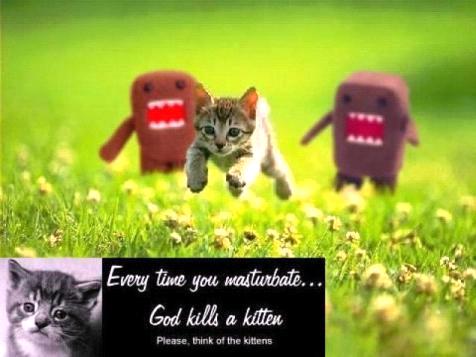
|























